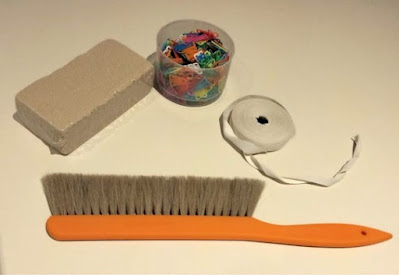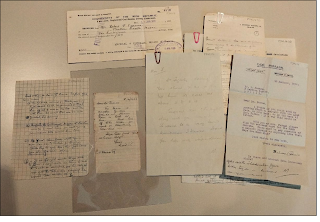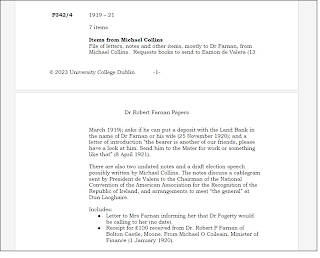As a trainee archivist undertaking the MA in Archives and Records Management in UCD, and working in UCD Archives, I have been learning how to catalogue archival collections. My colleagues worked on collections from the Royal Irish Academy for their cataloguing practice. As I work in a busy archive, I worked on two unprocessed collections in UCD Archives.
Archival collections consist of original and unique material which require careful handling to ensure their survival far into the future. There are professional standards and best practice procedures for processing archival collections that archivists carry out daily, in collection management (preservation and access), and archival cataloguing (arrangement and description). The aim of archival cataloguing is to establish physical and intellectual control of a collection to make it accessible for research.
 |
| Archivist's tools: Smoke sponge, plastic paperclips, cotton ribbon and a cleaning brush |
The collections I have worked on consist mostly of paper records from c.1900 – 1960s. When beginning a cataloguing project some basic preservation work is carried out to prevent the papers from deteriorating. Metal fastenings are removed, as these rust, and are replaced with plastic alternatives if necessary, or cotton ribbon to keep bundles of papers together. Cleaning may be required, using a smoke sponge to remove dirt, and a soft brush to remove surface dust or rust. Folded items are usually flattened using weights, as paper often tears along creases.
Archival arrangement involves
identifying which materials belong together, putting them into a logical order
(although we try to maintain the original order where possible) and assigning a
hierarchy. Broad subjects are arranged
as a series high up the hierarchy, with more specific topics arranged as
sub-series or files beneath, and single items at the bottom.
 |
| A file of documents written by Michael Collins (UCDA P342/4) |
Detailed descriptions of the
materials are written to create finding aids so that researchers can discover
what is in the collection, and reference numbers are given to each file and
item so that the archivist can retrieve the material and researchers can give
accurate citations.
 |
| The catalogue entry for the items from Michael Collins |
Papers are stored in acid free archival folders to keep
them secure and to help preserve them.
The reference numbers are written at the top of the page in pencil, and
on the front of the folder, so that the items can easily be identified and
matched to the finding aid. The folders
are then housed in an archival box, which is labelled, and stored in a strong
room.
.png) |
| An acid-free archival folder with four flaps and folders labelled with the collection name and reference numbers |
Research forms a large part of a cataloguing project, as understanding the context of the papers is crucial for arranging and describing them. A biographical history of the person whose papers are being catalogued helps to make sense of the papers, for both the archivists and the researcher and is therefore included in the finding aid.
The provenance of the papers is very important. As much information as possible is provided
about how the papers came to be in the archive, this includes when they were
deposited, who deposited them and their relationship to the person. A record is made of any changes to the
original order and the reason, and any conservation work carried out. This helps to maintain the integrity and authenticity
of the material.
 |
| Papers housed inside a labelled box and rolling shelving storage inside the strong room |
Collections can contain some unexpected items. I recently finished cataloguing the papers of Dr Robert Farnan (UCDA P342), which is a small collection with items relating to the 1916 Easter Rising, the War of Independence, and the Civil War period. I found an archival gem amongst these papers! I came across a sealed envelope with a handwritten note on the front:
Bullet removed from Right Radius of Tom Clarke first President Irish Republic. Feb 1916 by Dr F.
 |
| UCDA P432/1 |
I was eager to open the envelope, but I didn’t want to
cause any damage to either the envelope or anything else that might be
inside. Glue dries and turns brittle
overtime, so most of the glue used to seal the envelope was unstuck, I
carefully used a sharp scalpel to slice through the remaining glue. This was a success, and I was able to
retrieve the bullet which was wrapped inside a note confirming the information
on the envelope.
 |
| Metal bullet (11mm x 6mm) UCDA P342/1 |
I used a very small archival box
filled with cotton wool to store the bullet (see image below).
Discovering these kinds of items
make being an archivist so interesting, it was very satisfying knowing that I
was the first person to see the contents since the envelope was sealed.
 |
| The bullet is stored in archival box P342/1 |



.png)








0 comments:
Post a Comment